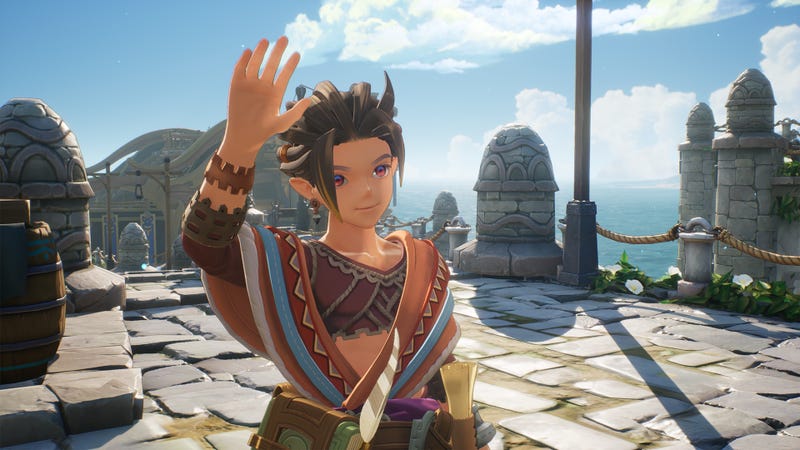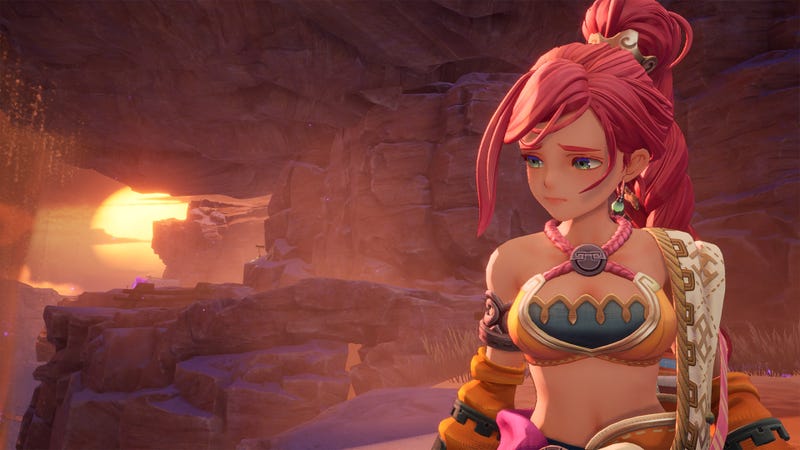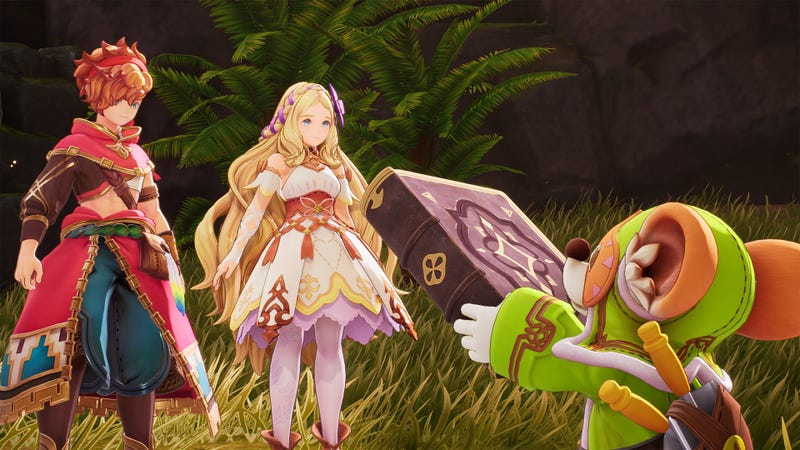There’s no outfit in gaming with a stronger history of telling tales about picking fights with God than Square Enix. Literally or metaphorically, from Final Fantasy Legend/SaGa and Star Ocean to Xenogears and even some Final Fantasies, a foundational narrative in which our heroes push back against a cruel, manipulative creator is like a spinal cord holding up many a juggernaut of Japanese RPG canon. But another enduring Square Enix series, quietly running just as long as the others, takes the opposite approach, embracing the positive side of religion and mythology. These are games about unity, the healing powers of nature, and the virtuous pride brought from trusting in a benevolent higher power. No, not Dragon Quest; yes, you visit churches to save in those games, but then you go and hang out in pubs and gamble like an exhausted salaryman. No, I’m talking about Mana.
Not unlike most games in the Final Fantasy series, each Mana game exists in its own timeline, yet they are tied together by recurring themes, characters, and constructs. The Tree of Mana is the most prominent symbol, the center of these games’ worlds, ecosystems, and cultures. The Tree gives life to everything, but is always vulnerable; a finite resource that must be protected and maintained across generations. The Goddess of Mana is a sort of representative of the Tree, managing the flow of life energy and communicating with people based on needs or traditions. Finally there’s the Sword of Mana, which is there to…help the heroes do their Hero Stuff. In each Mana game there’s typically some threat to the Tree or the Goddess, and the adventure is all about fighting the good fight in a way that’s never really been complicated or challenged. Until now.
A once-vibrant series, grown sickly
Visions of Mana is the fifth “mainline” entry in the series, the first since Dawn of Mana for the PlayStation 2 back in 2006. Square Enix has struggled with the series since, often dipping into the IP for experiments and remakes alongside a series of ill-fated mobile games. Visions is a big swing that couldn’t come at a tougher time for big swings with any IP, much less the smaller fries. But it’s here anyway, seeking to roll out the red carpet for a series that hasn’t had this kind of treatment since before video games ran in wide resolutions. There’s a lot to lose in terms of sales and money, but for a series with so many bumps in the road and fans desperate for one more chance, perhaps there’s nothing to lose for Mana itself.

As the game begins, everything seems normal. The world is full of vibrant life, its landscapes covered in trees and goofy-looking creatures that you almost feel bad fighting. Visions’ natural beauty and open spaces are punctuated by a swelling soundtrack that oozes happiness and joy, bringing to life what kids playing Super Famicom RPGs probably pictured in their minds when scrolling similarly colorful tiles in Secret of Mana. Your characters, a ragtag group of would-be heroes from around the world, are all smiles as they run across the environment or gallop upon one of many fantastic beasts, collecting flowers and Grizzly Syrup to trade for rare items with bears that speak like human infants. The vibes are simply majestic. But something is wrong, something only you, the player, can feel. Longtime Mana fans will feel it in their bones.
This is, as before, a world held up by the Tree of Mana, a gorgeous natural landmark towering above anything and everything else you can see, from volcanoes to man-made wonders. The flow of Mana spreads to every living thing, keeping the people sheltered and healthy. Every four years, the people in each parish come together to celebrate, throwing a festival in their distinct cultural traditions to invite their local Elemental deity to send a Fairy over and declare one resident an “Alm.” The chosen Alms band together with a chosen Soul Guard (a ceremonial bodyguard, basically), and the group makes a pilgrimage to the Tree of Mana so it can…consume their souls and keep the Mana going until the next round of heroes is chosen. Yeah, I don’t remember human sacrifice being part of the equation before, either!
A cheery surface with horrors underneath
And these aren’t the actions of a confused or misinformed populace. In Visions of Mana, the prophecies are legit. Human sacrifices are necessary to keep things normal and comfy. This isn’t just legend or culture warping into something foul over time, or human dedication being misguided. The Elementals aren’t intangible; they come hang out and party with their region’s locals and support the Alms on their quests. Everyone is friends with everyone else, because everyone is on the same page. They’ve seen what happens when an Alm doesn’t make it to the Tree. Disaster strikes and everything falls apart. The world just functions this way, and the people are happy to adhere to the rules. Alms are treated with great respect, and it’s an honor to be chosen as one. But the cracks are starting to show. Not everyone is happy with sending their loved ones off forever, and the Alms aren’t all smiles the whole way. But these sentiments of doubt or resistance are kept on the fringes, fleeting moments of sadness or fear from the Alms solved by pep talks and hugs.
Visions is not Final Fantasy X. This isn’t a journey in which the heroes are uncomfortable with the fine print of their task. And if they are, that discomfort is pushed aside or comforted away. There are rare moments of pushback, two of them key beats in the story. But they have dire, and immediate, consequences. The pain comes not from dread, but from veering off the path. Val, the game’s protagonist and Soul Guard of the current Alm convoy, learns this the hard way, in one of Visions’ rare instances of pushback from the heroes themselves. But even after a devastating loss, the rest of the crew cheers Val on, helping him refocus on the original purpose: leading his friends to give themselves to the world, so everyone else can maintain their happiness for another few years.

At first, I wasn’t sure what to do with all this. I expected conflict between the heroes and the systems demanding their sacrifice to be the central force driving the story, like in Final Fantasy X or I Am Setsuna. But it isn’t, and I was stunned at how the characters and story were so cooperative. I struggled to decide how I felt until I realized, after the credits rolled, what was actually happening. Maybe I’m crazy, but it felt like there was an additional layer to Visions’ story, something cooking on a meta level that didn’t hit me until I was almost done.
This world is sick, and so, too, is Mana itself. The series has been struggling for years to find its footing and its true identity in a swamp of failed experiments and misguided attempts at gacha mining. Visions of Mana is supposed to be its grand return, and yet, this whole premise feels wrong. Since when does the Tree of Mana eat people’s souls, and why are we so happy about it? Mana games are known for their brightness and hope, an almost sing-songy vibe that fuels what feels to us longtime series fans like nostalgia for the old school. Visions of Mana is full of that, from its romantic, adventurous energy to a voice cast full of wacky accents and over-the-top performances. Some of these performances go out of their way to pay tribute to cartoon classics, such as Claude Pertwee’s body of work at Hanna-Barbera or Ed Wynn’s Mad Hatter from Alice in Wonderland.
All this sweetness is pelted with horrible events, turns that would be shocking and momentum-crushing in other contemporary RPGs like Final Fantasy XVI. Here, however, the heroes press on weirdly quickly, finding ways to celebrate a fallen friend on the road. The story snaps back into place like a rubber band, wiggling but not breaking. Something would happen and my jaw would drop, only for Val to gleefully yell out “grrrrrizzly!” at the next floating dollop of syrup. Boy, did my wife hate the syrup by the end!
Clunkiness gives way to satisfaction
It’s confusing at first, like the tone can’t decide what it wants to be, or the voice direction was a misfire well off the Battleship grid. Everything is so normal, but a dark undercurrent that feels out of place in Mana keeps bumping into the surface from below. And the game doesn’t seem to acknowledge it! My confusion was compounded for a while, as I was simultaneously trying to make sense of this thematic strangeness and grappling with the other parts of this game, such as its action-RPG combat and its extensive class system.
In the midst of it all, I sometimes had a hard time deciding how much of a good time I was having. Visions of Mana has a distinct cadence to its action that likely won’t feel good to players as they suss out their initial impressions. I’ve seen it described as “clunky” a few times, and I understand the sentiment. It’s a slower game, and the game presents its combat in such a way that it can be hard to determine at first if it actually clicks or not in a satisfying way, if it has any sauce.

At PAX East earlier this year I was in a room with colleagues playing a Visions of Mana demo. While most players were following the demo’s given path, I found myself making camp in an open space and playing with the controls, testing the limits of what I could do. After all, the early trailers showed a lot of vertical action, an immediate signal to fans of character action games like Devil May Cry and Bayonetta. And Visions literally uses some of that genre’s language, such as encouraging you to “stagger” a button press to make a different move come out as opposed to just mashing. There’s more going on under the hood than meets the eye, but it’s difficult to actually make that stuff work in a normal fight.
I’m a big swords guy, and Visions’ class system gives Val a big sword. It gives each character three weapons to choose from (some classes are variants that share weapons but offer different abilities and stats), but look, if I see a big sword that’s too hard to swing in a satisfying, video game kind of way, I pick that sword. Turns out that was also my key to figuring out the sauce, as being careful with buttons to make my slow, heavy swings hit was the key to doing any meaningful damage at all!
Working against the game’s specific rules and limits (how many jumps or air dashes I can use before having to touch back down, for example) to extend my combos was something I found myself focusing on through the entire adventure. Part of that is because the class system is intriguingly cumulative, giving you new options that apply universally (like additional combat logic) alongside class-specific abilities. It took nearly the whole game before I got full access to the greatsword’s buttons! But figuring out my reach, how to effectively aim, working with the mostly independent CPU team, and so on and so forth was all part of unlocking how a “clunky” start could lead to something more rewarding over time.
Saving the world, saving the series
I eventually found the story rewarding as well, as that story ends up being, at heart, about a partnership between you and nature itself to help cleanse what’s causing all this avoidable pain. This is a classical, old-school, nostalgic RPG with all the silly voices and cute faces you can stomach. But it’s not well, and there’s something enveloping the game with a darkness that’s preventing it from being itself. The Tree of Mana isn’t just being a jerk for no reason, and even though the Alms are doing their learned duties with heart, you know that it doesn’t, shouldn’t have to be this way. By the end it almost feels like the conflict I was aching for was cast aside entirely, in favor of something far more mundane and trope-friendly. Any concerns about the Alms’ situation practically vanish when a big, evil dude shows up to destroy the world. “Welp, I guess we’re just doing this now,” is what the vibe seemed to be.
But then things I can’t spoil happened (I may have already said too much!), and in that moment of post-credits clarity, the pieces fell into place and I realized what I had accomplished. I helped heal Visions of Mana itself from its illness. Things were wrong, the world was not functioning properly. And the poor people doing their best to keep life worth living couldn’t see it. Even in the moments when they could feel it, even when Val at one point begged to be “the villain” under the weight of grief, the world was sticking to its guns and refusing to acknowledge the problem. But in those final moments, when my confusion almost turned to tears as the world was right again, I realized I had helped put Mana back on track. Just like so many folks out there hope Visions of Mana itself is doing. How do you put a score on that? I’m grateful I don’t have to this time.
.

Leave a Reply